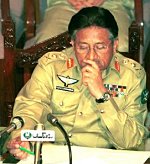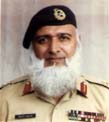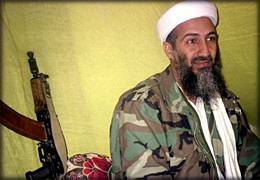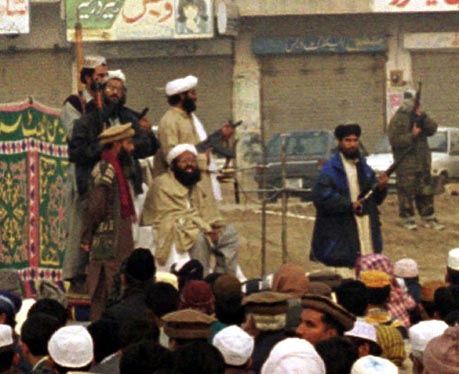|
|
|
Anti-Terrorism Campaign
An attempt to unravel the dirty secrets behind terrorism
|
Pakistan and Afganistan have had long bleak histories. Neither has seen anything close to a democratic governement survive very long.
Pakistan was formed on the basis of religion: something that today's mainly secular society would frown upon. The colonial rulers of India
(British) made sure that after centuries of robbying the country of everything it had, they would divide it along the volatile boundaries of religion.
The Pakistani Army is notorious in its urge to disrupt democratically elected governments at its whims. The coup by General Pervez Musharraf of
the Nawaz Sharief governenet in 1999 being the most recent example. Afganistan has long been associated with various warring tribes that have had a contiual
power struggle for centuries. They are now being overshadowed by the veil of Islamic fundamentalism in the form of the Taliban. Pakistan's long standing experience in exporting terrorism (Punjab, Kashmir and other regions of India; World Trade Center bombing; murder of CIA operatives outside their headquarters, African embassy bombings, etc.) has been a problem for many countries. India has by far been the longest standing victim of senseless terrorism eminating from Pakistan. As expected, some of the most notorious culprits in this high stakes 'game' reside in Pakistan or Afganistan. Though this list is by no means complete, some of the more familiar names are explored to get an idea of their motives and crimes. General Pervez Musharraf The General has been no stranger to terrorist activities
and human rights abuses in his career. Here are some excerpts from his resume: The General has been no stranger to terrorist activities
and human rights abuses in his career. Here are some excerpts from his resume:- "In May,1988, the Shias, who are in a majority in Gilgit, rose in revolt against the Sunni-dominated administration. Zia put an SSG group commanded by Gen. Musharraf in charge of suppressing the revolt. Gen. Musharraf transported a large number of Wahabi Pakhtoon tribesmen from the NWFP and Afghanistan, commanded by bin Laden, to Gilgit to teach the Shias a lesson. These tribesmen under bin Laden massacred hundreds of Shias. In its issue of May,1990, "Herald", the monthly journal of the "Dawn" group of publications of Karachi, wrote as follows: " In May 1988, low-intensity political rivalry and sectarian tension ignited into full-scale carnage as thousands of armed tribesmen from outside Gilgit district invaded Gilgit along the Karakoram Highway. Nobody stopped them. They destroyed crops and houses, lynched and burnt people to death in the villages around Gilgit town. The number of dead and injured was put in the hundreds. But numbers alone tell nothing of the savagery of the invading hordes and the chilling impact it has left on these peaceful valleys." Similar treatment was handed out to those opposing the Islamic zealots in Sindh and Balochistan.  -"After the visit of Mr.Strobe Talbott, US Deputy Secretary of State, to Pakistan in the first week of February, Mr.Sharif also approved a
plan submitted by Gen. Musharraf for shifting bin Laden's terrorist brigade from the Jalalabad area of Afghanistan to the Kargil area of
India by taking advantage of the absence of the Indian army from this area during winter. It is reported that while Lt.Gen. Nasir (left) strongly
backed the plan, Lt.Gen, Ziauddin, the Director-General of the ISI, expressed strong reservations over it and pointed out that it could
create problems for Pakistan with the US. Gen. Musharraf transferred Lt.Gen. Aziz from the ISI to the Army HQ. as his CGS and made him
responsible for its implementation through the Directorate of Military Intelligence. Lt.Gen. Nasir was kept in the picture about the
implementation, but not Lt. Gen. Ziauddin. -"After the visit of Mr.Strobe Talbott, US Deputy Secretary of State, to Pakistan in the first week of February, Mr.Sharif also approved a
plan submitted by Gen. Musharraf for shifting bin Laden's terrorist brigade from the Jalalabad area of Afghanistan to the Kargil area of
India by taking advantage of the absence of the Indian army from this area during winter. It is reported that while Lt.Gen. Nasir (left) strongly
backed the plan, Lt.Gen, Ziauddin, the Director-General of the ISI, expressed strong reservations over it and pointed out that it could
create problems for Pakistan with the US. Gen. Musharraf transferred Lt.Gen. Aziz from the ISI to the Army HQ. as his CGS and made him
responsible for its implementation through the Directorate of Military Intelligence. Lt.Gen. Nasir was kept in the picture about the
implementation, but not Lt. Gen. Ziauddin.
While outwardly supporting the Lahore Declaration, Gen. Musharraf, with the backing of Lt.Gen. Nasir, went ahead implementing the plan. Bin Laden's terrorist brigade was transported to Skardu in the Northern Areas and from there infiltrated into the Kargil area along with a large number of Pakistani army regulars. Mr.Sharif was allegedly not kept in the picture about sending the army regulars into Indian territory along with the terrorist brigade." (3) Osama Bin Laden He rose to prominence in the 1980s as a staunch opponent and fighter of Soviet troops in Afghanistan, acting as one of the main leaders
of the Arab volunteers. After the war, he went into exile in Sudan running several businesses. He is wealthy,
elusive and an Islamic extremist who has been plotting against India, Israel and the United States for the past decade. Bin Laden
left Sudan in 1996 and has since been holed up in various terrorist camps in Afganistan. He rose to prominence in the 1980s as a staunch opponent and fighter of Soviet troops in Afghanistan, acting as one of the main leaders
of the Arab volunteers. After the war, he went into exile in Sudan running several businesses. He is wealthy,
elusive and an Islamic extremist who has been plotting against India, Israel and the United States for the past decade. Bin Laden
left Sudan in 1996 and has since been holed up in various terrorist camps in Afganistan."Bin Laden's message circulating in Pakistan's deeply conservative Northwest Frontier Province depicts burning U.S., Indian and Israeli flags and a cocked Kalashnikov rifle ready to fire. "The youth should contact us as soon as possible," the message says. "Territorial boundaries have no importance in our eyes. All the land belongs to God." Bin Laden's message, written in Urdu, Pakistan's national language, vowed to continue his battle against America. "Our jihad will continue until America is expelled from Saudi Arabia and other countries of the world," bin Laden's message said. "It is our responsibility to free the world from their [U.S.] control," it said. "The non-Muslim world should know it well that a Muslim is always ready to die in the name of God. I am not afraid of America. I will continue my work. No one can stop me," the message said." (4) Bin Laden has been implicated in among other things the killing of U.S. troops in Somalia, the New York World Trade Center bombing, the two bomb blasts at US Army bases in Saudi Arabia, murder of CIA operatives outside their headquarters, the embassy bombings in Kenya and Tanzania, violence in Kashmir and the current hostage situation in the Philipines. Masood Azhar Part of the Indian Airlines hijacking deal was the release of Masood Azhar. His main goal in India was to broker a merger various
terrorist groups operating in Kashmir; the Harkat-ul-Mujahideen (HuM) and the Harkat-ul-Jihad Islami (HuJI), into the Harkat-ul-Ansar (HuA).
He was arrested in Febuary of 1994 while returning from a terrorist meeting with at Matigund village, near Anantnag. In his pocession at the time
of his arrest was cash, airline tickets and a fake Portugese passport that was obtained from contacts in London. The hijacking was not the first
attempt by his fellow terrorists to gain his release from custody. Azhar's arrest was followed by the kidnapping of British tourists Tim
Housego and David Mackey. In October 1994, British national Ahmed Umar (Omar) Syed Sheikh, who has now been released as part of the hostages-for-terrorists exchange
in Kandahar, organised the abduction of four British nationals from a guest house in New Delhi. The victims were located by intelligence
agencies in the state of Uttar Pradesh. Sheikh and his accomplice, a Pakistani national Abdul Rahim were arrested. The hostages
were rescued and one police officer killed in the operation.
Part of the Indian Airlines hijacking deal was the release of Masood Azhar. His main goal in India was to broker a merger various
terrorist groups operating in Kashmir; the Harkat-ul-Mujahideen (HuM) and the Harkat-ul-Jihad Islami (HuJI), into the Harkat-ul-Ansar (HuA).
He was arrested in Febuary of 1994 while returning from a terrorist meeting with at Matigund village, near Anantnag. In his pocession at the time
of his arrest was cash, airline tickets and a fake Portugese passport that was obtained from contacts in London. The hijacking was not the first
attempt by his fellow terrorists to gain his release from custody. Azhar's arrest was followed by the kidnapping of British tourists Tim
Housego and David Mackey. In October 1994, British national Ahmed Umar (Omar) Syed Sheikh, who has now been released as part of the hostages-for-terrorists exchange
in Kandahar, organised the abduction of four British nationals from a guest house in New Delhi. The victims were located by intelligence
agencies in the state of Uttar Pradesh. Sheikh and his accomplice, a Pakistani national Abdul Rahim were arrested. The hostages
were rescued and one police officer killed in the operation. Finally, in July 5, 1995, a shadowy outfit called Al Faran took five Western tourists hostage from Pahalgam. One of the hostages, Norwegian national Hans Christen Ostro, was beheaded early on by the kidnappers, in a move to pressure Western governments to force India to bring about Azhar's release. Keith Mangan and Paul Wells of Britain, Donald Hutchings of the U.S., Dirk Hassert of Germany are widely believed to have been shot dead on Christmas Day in 1995, shortly after HuA chief Hamid Turki was killed in an encounter with the Indian Army near Doda. Frustrated by their failure to secure the prisoners' release, and angered by Turki's death, the kidnappers are believed to have given orders for the hostages' execution. (5) In this picture, he gives a clarion call to his extremist supporters to pick up the gun and renew the battle for Kashmir's liberation at an Id prayer meeting in Bawahalpur, Pakistan. Azhar has revealed his militant ambitions and has threatened to unite Muslim volunteers in his bid to win the jehad in Kashmir, Bosnia and the breakaway Russian territory of Chechnya. (6) His newly formed outfit, Jaish-e-Mohammed could have upto 5,000 terrorists in its ranks. The above picture also provides an upclose and personal portrait of the state of Pakistan; a flourishing gun culture combined with religious fanaticism. In a similar rally in Karachi Pakistan Azhar stated, "I have come here because this is my duty to tell you that Muslims should not rest in peace until we have destroyed America and India". (7) Thousands of OthersThere are thousands of other terrorists that are causing havoc all over the world, and thousands more are being trained in Pakistan, Afganistan, Sudan, Britain and even the United States of America (8). Five were implicated by Indian authorities (9) in the Christmas hijacking of the Indian Airlines flight 814. They are most likely in Pakistan or Afganistan being rewarded for their terrorist acts. These two countries continue to use all resources, in Pakistan's case its military and ISI to train and equip terrorists (10). Hundreds of other terrorists have been killed or captured by authorities in India. Still various terrorist groups operate with impunity, groups that must be identified and eliminated. |
| |